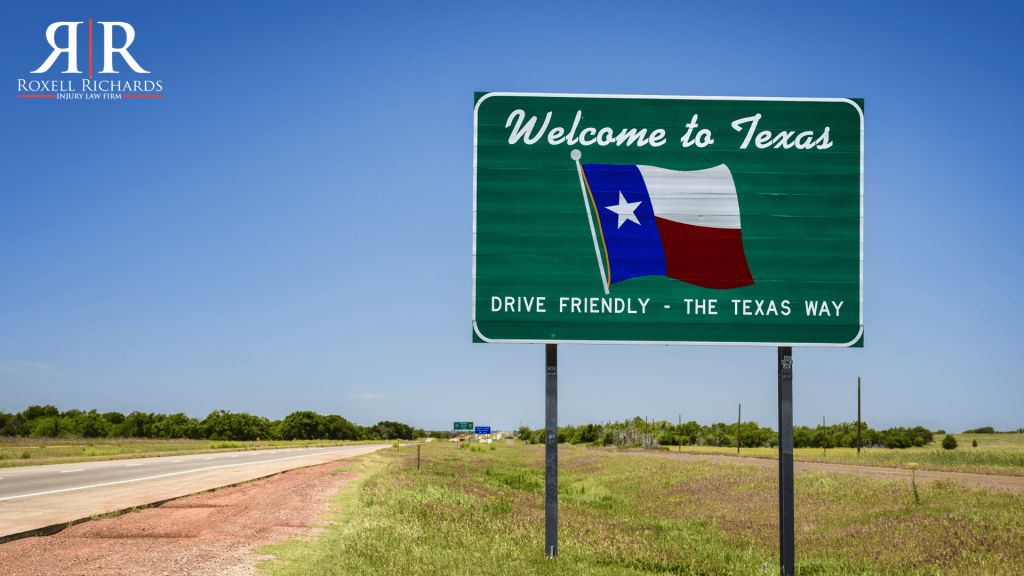Crossing State Lines: Out of State Car Accident Jurisdiction
You might not have heard of the out-of-state car accident jurisdiction. And your involvement in a car accident in a state other than your own can raise questions about liability. Moreover, it can also raise insurance policies and the legal process.
This blog aims to shed light on the jurisdictional aspects of car accidents outside your home state, specifically focusing on the differences between Texas and California.
Let’s explore the car accident liability and laws in Texas and the car accident policies and settlements in California. And to understand better how each state handles out-of-state car accidents.

Car Accident Liability and Laws in Texas
In Texas, determining car accident liability is according to the concept of “fault.” The at-fault party is responsible for compensating the damages from the accident.
So, regarding auto accidents, Texas is not a no-fault state. Instead, it follows a fault-based system where the at-fault driver and their insurance company cover the damages and losses resulting from the accident.
In fact, establishing negligence or wrongful actions that led to the collision is crucial to determine liability accurately.
Moreover, insurance companies and legal professionals assess these factors to allocate fault percentages to each party involved.
Also, a car accident law in Texas encompasses a range of designs for statutes and regulations. And this addresses the legal implications of automobile collisions and protects the rights of those involved.
So, understanding the key elements of car accident law is essential for drivers in Texas to know their rights, obligations, and potential recourse in case of an accident.
And here are some essential aspects of car accident law in Texas:
Fault-Based System
Texas follows a fault-based system for determining liability in car accidents. This means that the driver found at fault for causing the accident is responsible for compensating the other parties for their damages and injuries.
And determining fault through various means. For example:
- police reports,
- witness statements,
- photographs, and
- collection of other evidence at the accident scene.
Statute of Limitations
Texas has a statute of limitations that sets a time limit on filing a lawsuit after a car accident.
So, for most personal injury claims arising from car accidents, the injured party has two years from the accident date to initiate legal action.
And the right to seek restitution through the legal system may be lost due to the failure to file a case within this window of opportunity.
Modified Comparative Negligence
Texas follows a modified comparative negligence rule when determining compensation in car accident cases.
And under this rule, a person’s compensation is proportionate to their percentage of fault. However, barring a person’s compensation for recovery can be possible if found to be 51% or more at fault for the accident.
Mandatory Auto Insurance
In Texas, it is a requirement for drivers to carry a minimum level of liability insurance coverage to operate a motor vehicle legally.
And the minimum liability coverage includes liability for bodily harm and property damage.
Also, this insurance helps cover the costs of injuries and property damage brought to others in an accident where the insured driver is at fault.
Seat Belt Law
Texas has a primary seat belt law, which means law enforcement can stop and ticket drivers solely for not wearing seat belts.
Additionally, all passengers, including those in the back seat, must wear seat belts.
Comparative Responsibility for Uninsured Motorists
Texas has a “proportionate responsibility” system for uninsured motorist claims. So, if the at-fault driver is uninsured, the injured party’s uninsured motorist coverage may apply.
And considering the injured party’s own fault, reducing their compensation accordingly.
Dram Shop Law
Texas has a “dram shop” law that holds establishments, such as bars or restaurants, liable for injuries. Especially if they have been found serving alcohol to visibly intoxicated individuals who later cause car accidents.
Also, this law aims to discourage the over-service of alcohol to customers and reduce drunk driving incidents.
So, a comprehensive understanding of car accident law in Texas is vital for drivers to protect their rights and make informed decisions in case of an accident.
From fault determination and comparative negligence to mandatory insurance requirements and seat belt laws, knowing the legal landscape can help individuals. Furthermore, help them navigate the aftermath of a car accident with greater confidence. Also, this will ensure they receive the compensation they deserve when they are not at fault.
So, in your involvement in a car accident, we highly recommend seeking legal advice from an attorney with qualifications and experience in Texas car accident law. Because they will do everything to protect one’s interests and rights throughout the process.
Car Accident Policies and Settlements in California
Car accidents can be traumatic and financially burdensome events. And in California, understanding the car accident policies and settlement process is essential for individuals. Especially for those involved in accidents, to protect their rights and seek fair compensation.
In fact, California operates as a no-fault state for car accidents. Therefore, in states that follow the no-fault system and experience an accident, drivers depend on their own insurance coverage to manage expenses related to the accident. And this is the case irrespective of who is responsible for causing the collision.
Also, California’s car accident policy adheres to the at-fault system for insurance claims. And the party found responsible for the accident, and their insurer is liable for the damages incurred by others involved in the collision.
So, here’s an overview of car accident policies and settlements in California:
Car Accident Policies in California
Liability Insurance
California law requires drivers to carry liability insurance that covers bodily injury and property damage. This insurance compensates other parties involved in an accident if the insured driver is at fault.
California’s minimum liability coverage limits are typically expressed as three numbers, such as 15/30/5, representing $15,000 for bodily injury per person, $30,000 for bodily injury per accident (if multiple people are injured), and $5,000 for property damage.
Uninsured/Underinsured Motorist Coverage
While not mandatory, insurance companies in California must offer uninsured and underinsured motorist coverage.
And this coverage protects you if you are involved in an accident with a driver who lacks sufficient insurance or is uninsured.
Personal Injury Protection (PIP)
California does not require personal injury protection (PIP) coverage. In fact, PIP, also known as no-fault insurance, covers medical expenses and lost wages for the policyholder and passengers. And this is regardless of who caused the accident.
However, PIP coverage may be available as an optional add-on in California.
Car Accident Settlements in California
- Initiation of Settlement Process: After a car accident, the injured party typically initiates the settlement process by filing a claim with the at-fault driver’s insurance company. And the claim will outline the details of the accident, the injuries sustained, and the damages incurred.
- Investigation: Insurance adjusters will investigate the accident, review medical records, assess property damage, and determine the extent of liability. And they will use this information to make an initial settlement offer.
- Demand Letter: If you are the injured party seeking compensation, your attorney may prepare a demand letter. And this will state the amount you seek for medical expenses, lost wages, pain and suffering, and other damages.
- Negotiations: The insurance company representing the at-fault driver may respond with a counteroffer. Also, negotiations between both parties may continue until a mutually acceptable settlement amount is reached.
- Settlement Agreement: Once both parties agree on a settlement amount, they will sign a formal settlement agreement. And by signing this agreement, you agree to accept the specified amount as full and final compensation for your injuries and damages.
- Payment and Release: The at-fault driver’s insurance company will provide the agreed-upon payment after the signed settlement agreement. And in return, you will provide a signed release, releasing the at-fault driver and their insurance company from any further liability related to the accident.
Comparison of Car Accident Laws in Texas and California
Car accident laws vary from state to state. And understanding the differences between Texas and California can be crucial for individuals involved in out-of-state car accidents.
So, here’s a comparison of some key aspects of car accident laws in both states:
Fault-Based vs. No-Fault System
- Texas: Texas follows a fault-based system, where the driver determined to be at fault for the accident is responsible for compensating the other parties for their damages and injuries.
- California: California, on the other hand, operates under a no-fault system for car accidents. And in no-fault states like California, each driver’s insurance company covers their policyholder’s medical expenses and other losses, regardless of who the at-fault is.
Statute of Limitations
- Texas: In Texas, the statute of limitations for filing a car accident lawsuit is generally two years from the accident date.
- California: In California, the statute of limitations for personal injury claims arising from car accidents is also typically two years from the accident date.
Comparative Negligence
- Texas: Texas follows a modified comparative negligence rule. And this allows for compensation according to each party’s percentage of fault, as long as they are not 51% or more at fault. If a party is found to be 51% or more at fault, they may be barred from recovering any compensation.
- California: California also follows a comparative negligence system, allowing for compensation according to the percentage of fault.
However, California applies a pure comparative negligence rule. And this means a person can recover damages even if they are 99% at fault for the accident. Unfortunately, they are reducing their compensation accordingly.
Uninsured/Underinsured Motorist Coverage
- Texas: Uninsured/underinsured motorist coverage is required in Texas, protecting if the at-fault driver in an accident has insufficient insurance or is uninsured.
- California: Uninsured/underinsured motorist coverage is not mandatory in California, but insurance companies must offer it to policyholders. In fact, drivers have the option to reject this coverage in writing.
Seat Belt Laws
- Texas: Texas has a primary seat belt law, allowing law enforcement officers to stop and ticket drivers solely for not wearing seat belts. All passengers, including those in the back seat, must wear seat belts.
- California: California also has a primary seat belt law, which mandates seat belt usage for all occupants in a vehicle.
Dram Shop Law
- Texas has a dram shop law, holding establishments liable for injuries due to serving alcohol to visibly intoxicated individuals who later cause car accidents.
- California does not have a specific dram shop law. Instead, social hosts and businesses may face liability under general negligence principles if they provide alcohol to someone who subsequently causes an accident.
In fact, crossing state lines and getting involved in a car accident can be complex and challenging.
So, being familiar with the car accident liability laws in Texas and California’s car accident policies and settlements is essential for anyone travelling between these states.
But you can contact law offices with the best personal injury and car accident attorneys for free consultation and assistance.
And by understanding the distinctions in their legal systems, individuals can make informed decisions. But more importantly, protect their interests when dealing with out-of-state car accidents.
So, check for case results and testimonials for those injured in a car accident.




